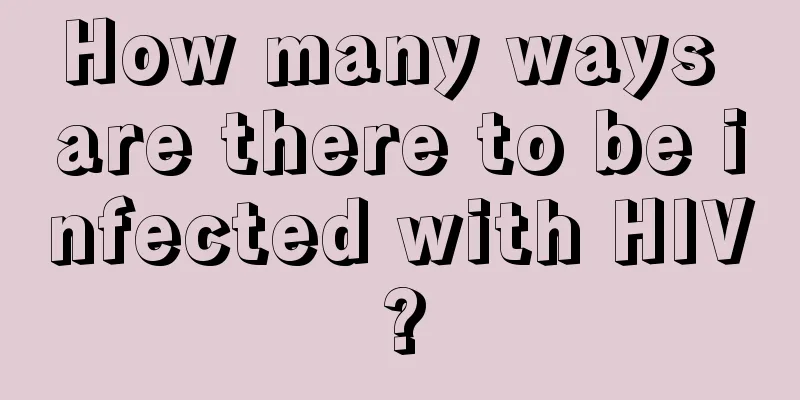How many ways are there to be infected with HIV?

|
There are more and more AIDS patients. Many people are afraid when they hear the word AIDS. Many people dare not come into contact with AIDS patients because they are afraid that they will get AIDS after contacting them. This is because they do not understand how AIDS is transmitted. In fact, the main ways of transmission of AIDS are sexual contact, blood transmission and mother-to-child transmission. How are they transmitted? 1. Transmission routes of AIDS AIDS is a common sexually transmitted disease that is extremely harmful to human health. There is currently no complete cure. The main ways of AIDS infection are sexual contact, blood transmission, and mother-to-child transmission. Blood transmission includes the transfusion of contaminated blood products, or sharing of needles, major medical accidents, etc., all of which can easily lead to infection with the HIV virus. (1) Sexual contact transmission: Includes sexual contact between the same and opposite sexes. (2) Blood transmission: include: ① Transfusion of HIV-contaminated blood or blood products; ② Intravenous drug addicts share HIV-contaminated, unsterilized needles and syringes; ③ Sharing other medical equipment or daily necessities (such as sharing toothbrushes or razors with infected people) may also cause infection through damaged areas, but this is rare. ④ Incomplete or no disinfection of syringes and needles: Especially for children, preventive injections that are not given one needle and one tube per child are more dangerous; oral instruments, delivery instruments, surgical instruments, and needles for acupuncture treatment are not strictly disinfected or are not disinfected; needles and shaving tools for haircuts, beauty treatments (such as eyebrow tattoos, ear piercings), tattoos, and pedicure knives in the bathroom are not disinfected; sharing razors, razors, or toothbrushes with others; transfusions of blood or blood products from donors who have not been tested for HIV antibodies, as well as bone marrow transfusions and organ transplants in similar situations; when rescuing a bleeding casualty, the rescuer's own broken skin comes into contact with the casualty's blood. (3) Mother-to-child transmission: Also known as perinatal transmission, it means that an HIV-infected mother transmits HIV to the fetus or baby before, during, and shortly after birth. It can be transmitted through the placenta, through the birth canal during delivery, or through breastfeeding. After knowing these transmission routes of AIDS, you can take preventive measures and no longer have to avoid AIDS patients, because general contact will not infect you with the virus. However, if any adverse reaction occurs in the body, you should go to the hospital for examination and treatment in time. |
<<: How long does a low-grade fever last?
Recommend
Caressing breasts creates a "sexually blissful" feeling
Breasts play a very important role in sex. If you...
7 tips on sex skills to make him want you
Being mature does not necessarily mean being char...
Fingers make her squirt
Many people will feel strange, how can fingers do...
Is having sex every day bad for your health?
For young couples, this is the period when sexual...
You can only understand what type of man he is after having sex.
1. A long sigh He is an impatient man who likes t...
How to choose the size of condom?
When buying condoms, I wonder if you have ever pa...
What is the cause of bleeding after sleeping together?
Bleeding after sex is caused by many problems, on...
Revealing the eight reasons why “quick gun” men ejaculate too quickly!
Ejaculating too quickly is one of the troubles of...
10 reasons why women need besties
No matter how great a man is, he can never replac...
How to take contraceptive measures
Living together before marriage is a relatively n...
Discharge after sex
After making love, women will have secretions flo...
Are women shy in bed? Four ways to stimulate the "sultry girl"
During sex, not every woman can have her sexual d...
There are 8 things women should not say
1. Don’t say discouraging words Some people often...
Eight super Indian sex positions that are most likely to make her climax
Variation of jellyfish If the male partner has go...
What are the symptoms of excessive psychological stress?
Have you ever thought about suicide? Even if it’s...









